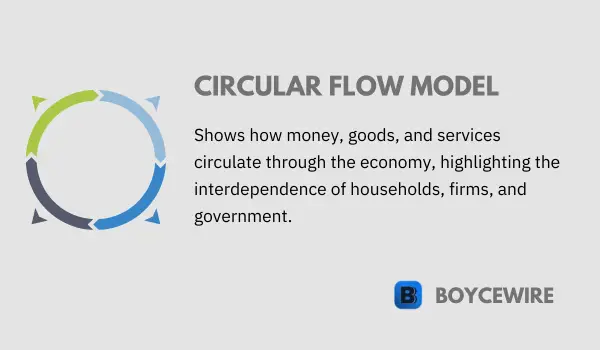Circular Flow Model: Definition, Sectors & Examples

What is the Circular Flow Model?
The circular flow model is a simplified representation of an economy, illustrating the flow of money, goods, and services between households and firms. This model provides a foundation for understanding the interactions between different sectors of an economy and helps identify the impacts of various economic policies. In this article, we will explore the key components of the circular flow model and discuss its importance in understanding how the economy functions.
Key Points
- The circular flow model is a simplified representation of how money, goods, and services flow through the economy between households and firms.
- The model includes two main components: the flow of money and the flow of goods and services.
- The flow of money represents the exchange of money between households and firms for goods and services, while the flow of goods and services represents the exchange of goods and services between households and firms.
- The circular flow model illustrates how households and firms are interdependent and rely on each other for their economic well-being.
5 Sector Circular Flow Model
The circular flow model is a representation of an economy that illustrates the flow of resources, goods, services, and income between different sectors. The main sectors of the circular flow model are:
Households represent individuals and families who consume goods and services, supply labor, and receive income from firms. Households spend their income on consumption, save it, or pay taxes to the government.
Firms produce goods and services using resources (labor, capital, and natural resources) provided by households. They generate revenue by selling these goods and services to households, other firms, or the government. Firms also pay wages, rent, and profits to households in return for the resources they provide.
The government sector collects taxes from households and firms and uses this revenue to provide public goods and services, such as education, healthcare, and infrastructure. The government also regulates economic activity and redistributes income through social welfare programs. Additionally, the government can influence the economy through fiscal policy (taxation and government spending) and monetary policy (managing money supply and interest rates).
Financial institutions, such as banks and investment firms, facilitate the flow of funds between households, firms, and the government. They collect savings from households and provide loans to businesses, helping allocate resources efficiently and maintain stability in the financial system.
The foreign sector includes all economic transactions between the domestic economy and the rest of the world, such as exports, imports, and financial flows. The circular flow model can be extended to include international trade, which adds an additional layer of complexity as goods, services, and capital flow across borders.
Households spend their income on goods and services produced by firms in the product market. This spending represents revenue for firms, which is used to pay for the factors of production provided by households.
Firms pay households for the factors of production they provide in the factor market. This payment constitutes the income households receive, which is then spent on goods and services in the product market.
- Investment (I): Firms invest in new capital goods, such as machinery, equipment, and buildings, to expand production and increase future profits. This investment acts as an injection into the circular flow, as it increases overall spending and demand for goods and services.
- Government Spending (G): The government sector spends money on public goods and services, such as education, healthcare, and infrastructure. This spending acts as an injection into the circular flow by increasing demand for goods and services, which in turn can stimulate production and employment.
- Exports (X): When a country exports goods and services to other countries, it receives payment in return. These export revenues act as an injection into the circular flow, as they increase overall income and spending in the domestic economy.
- Savings (S): Households may choose to save a portion of their income rather than spend it on consumption. Savings act as a leakage from the circular flow, as they reduce the overall spending and demand for goods and services.
- Taxes (T): The government collects taxes from households and firms, which reduces their disposable income and spending. Taxes act as a leakage from the circular flow, as they decrease overall demand for goods and services.
- Imports (M): When a country imports goods and services from other countries, it spends money to pay for them. These import expenditures act as a leakage from the circular flow, as they reduce overall income and spending in the domestic economy.
- Households provide labor, land, and capital to firms in exchange for wages, rent, and interest or profit. This is the factor market, where firms purchase resources needed for production.
- Firms use these resources to produce goods and services, which are then sold to households in the product market.
- Households spend their income on goods and services, generating revenue for firms.
- The income earned by households is then used to consume goods and services produced by firms, creating a circular flow of income and spending.
- Households provide labor, land, and capital to firms in exchange for wages, rent, and interest or profit, just like in the two-sector model. However, households also pay taxes to the government and receive transfer payments (e.g., social security) and subsidies.
- Firms produce goods and services, sell them to households, the government, and the foreign sector (exports), and pay taxes to the government.
- The government collects taxes from households and firms and spends on public goods and services, such as education, healthcare, and infrastructure. This government spending is an injection into the circular flow.
- The foreign sector injects money into the economy through exports and creates a leakage through imports. The balance between exports and imports (net exports) determines the impact of the foreign sector on the circular flow.
1. Households
2. Firms (Businesses)
3. Government
4. Financial Institutions
5. Foreign Sector (International Trade)
These sectors interact with each other through various markets, such as the goods and services market, the labor market, and the financial market, creating a continuous flow of resources, goods, services, and income throughout the economy.
The Circular Flow of Income
The circular flow model demonstrates how income is generated and circulated within an economy. There are two main income flows:
Income flow from households to firms
Income flow from firms to households
The factor market and product market facilitate the flow of income between households and firms, creating a continuous cycle of income generation and spending within the economy.
Leakages and Injections in Circular Flow of Income
In the circular flow model, injections and leakages play a crucial role in maintaining the balance of the economic system. Injections are the funds that enter the circular flow from sources outside the system, while leakages are the funds that exit the circular flow. Understanding the relationship between injections and leakages helps explain the overall performance and stability of an economy.
Injections
Injections are funds that are introduced into the circular flow, increasing the flow of income and expenditure. The main types of injections are:
Leakages
Leakages are funds that exit the circular flow, reducing the flow of income and expenditure. The main types of leakages are:
In a balanced economy, the total injections should equal the total leakages. If injections exceed leakages, the economy will expand, leading to increased production, employment, and income. Conversely, if leakages exceed injections, the economy will contract, leading to decreased production, employment, and income. Policymakers use fiscal and monetary policies to influence the balance between injections and leakages, aiming to maintain economic stability and achieve growth objectives.
Circular Flow Model Examples
Here are two examples of the circular flow model to help illustrate how it works in practice:
Two-Sector Circular Flow Model
In this simplified model, there are only two sectors: households and firms. The model demonstrates the interactions between these two sectors in terms of income, production, and spending.
Four-Sector Circular Flow Model
In this more complex model, there are four sectors: households, firms, government, and the foreign sector. This model accounts for government intervention and international trade.
These examples demonstrate how the circular flow model can be used to understand the flow of income, spending, and production in different economic contexts.
FAQs
The circular flow model is a simplified representation of how money, goods, and services flow through the economy between households and firms.
The circular flow model includes two main components: the flow of money and the flow of goods and services.
The flow of money represents the exchange of money between households and firms for goods and services. Households provide money to firms in exchange for goods and services, while firms provide money to households in exchange for factors of production such as labor.
The flow of goods and services represents the exchange of goods and services between households and firms. Households provide factors of production such as labor to firms in exchange for wages, while firms provide goods and services to households in exchange for money.
About Paul
Paul Boyce is an economics editor with over 10 years experience in the industry. Currently working as a consultant within the financial services sector, Paul is the CEO and chief editor of BoyceWire. He has written publications for FEE, the Mises Institute, and many others.

Further Reading
 Fascism vs Communism - Fascism emphasizes national unity and the supremacy of one race or ethnicity, while communism promotes equality and the abolition of…
Fascism vs Communism - Fascism emphasizes national unity and the supremacy of one race or ethnicity, while communism promotes equality and the abolition of…  Gross National Income Definition - GNI, or Gross National Income, is the total value of goods and services produced by a country's residents, including income…
Gross National Income Definition - GNI, or Gross National Income, is the total value of goods and services produced by a country's residents, including income…  Present Value: Definition, Criticisms & Example - Present value (PV) is the current value of a future sum of money, or stream of revenue. Tihs is calculated…
Present Value: Definition, Criticisms & Example - Present value (PV) is the current value of a future sum of money, or stream of revenue. Tihs is calculated… 
